Around 11 p.m. on Friday in Ouray, Helen gave the “let’s go.”
I was shadowing Helen Pelster, a Truckee ultrarunner, since she was Betsy Nye’s crew chief, and I had eagerly volunteered to travel to Colorado to help crew and pace Betsy.
I stepped outside the condo rental, located right next to the Hardrock 100 Endurance Run aid station, and looked at the night sky framing Ouray’s box canyon. A sheet of lightning illuminated the silhouette of Red Mountain, then a fork of electricity split the sky. Thunder boomed and a downpour of rain intensified.
Betsy and the 139 other Hardrock runners who had been running and hiking since 6 a.m., minus a dozen or so who’d already dropped out, were somewhere on the mountainsides in that storm—the second major storm of the day.
Soon I would be, too.
The first downpour came in the early afternoon in Telluride, mile 28 on Hardrock’s clockwise course (the course switches direction each year), where I waited with Helen and the rest of the crew for Besty and her husband, Paul Sweeney, both of whom were running Hardrock—Betsy’s 13th, Paul’s 7th.
I got there before 11:30 a.m. to see the likes of Kilian Jornet, Timothy Olson, Dakota Jones and other mountain runners I can’t help but follow like a groupie. A who’s who of the sport had made a pilgrimage to crew and watch: Anton Krupicka with his trucker cap and bare feet, Tropical John Medinger with his aloha shirt and oversized camera, Meghan Hicks with her laptop and phone ready to tweet pics and updates for iRunFar. Anna Frost in her cute skort, James Varner in his Rainshadow Running cap. Too many names to name.
The scene felt like a community picnic, and as I looked across the field to the stage where a weekend music fest was setting up, I flashed back to the trippy afternoon in 1987 when I was a college student and saw the Grateful Dead play there in Telluride during the Harmonic Convergence. Telluride Town Park sets my brain abuzz with wistful memories. It’s where I watched my dad play baseball in a community league, where I took my kids innumerable times to fish in the pond, to climb on the play structure and to skate in the rink—and now, for the second time (the first in 2011), it’s the aid station where I’ve plugged into Hardrock.
But as the time approached for the front-runners to arrive, the gathering gave off a giddy anticipation as if watching the World Cup. It was Hardrock weekend, after all, and if you weren’t one of the 140 crazy-fit-lucky trail runners who qualified and got picked in the lottery to run it, then the next best thing was to be a pacer and/or crew member spending the event’s 48 hours in and around the three soulful, historic mining towns that form the Hardrock loop: Telluride, Ouray, Silverton.
I met up with my brother and sister-in-law who biked into town from their home. Suddenly a mummer went through the crowd, and the Salomon paparazzi moved into place—here comes Killian!
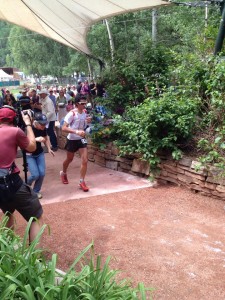
Kilian Jornet leaving the Telluride Aid Station. He was the eventual winner and broke the course record by 40 minutes, finishing in 22:41.
It’s interesting to watch top competitors go through an aid station relatively early in the event because they breeze through so efficiently and poker-faced. They barely stopped to receive aid from their crews. Only Timothy Olson paused like a regular guy to kiss and hug his wife and son. The runners who began trickling in after the top 10, however, took more time to refuel and adjust gear.
Sometime around 1 p.m., the clouds thickened above town and turned gun-metal gray. The mercurial weather in the San Juan Mountains is like the meteorological version of Vladimir Putin—ridiculously powerful and unpredictably shifting from mild to menacing. Extra-large raindrops sprinkled for a minute and then coalesced into a full downpour, with thunder booming above.
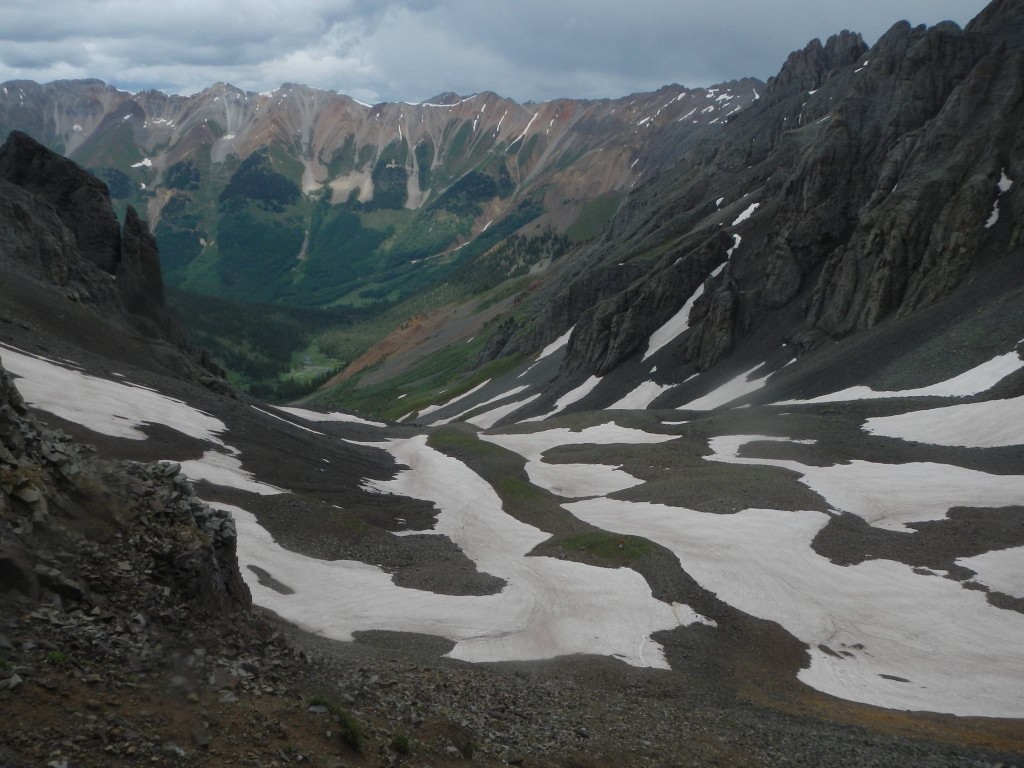
Remnants of storm clouds over Oscar Pass as seen from Grant Swamp Pass. These are the two passes leading to Telluride. Hardrock runners go over multiple mountain passes like this. Photo by Chihping Fu
Running down from the 13,000-foot Oscar’s Pass—the third of ten major passes on the course—Betsy, Paul and others were pelted with hail and thoroughly drenched. At the aid station, everyone huddled into a cramped space under white canopies.
We spotted Betsy around 2:35 and moved into action, changing her into fresh shoes and socks, adjusting her ankle brace (she had sprained her ankle several weeks earlier, which hampered her training), rubbing ointment on her legs, getting her hot soup, refilling her hydration pack—in short, attending to all the details that make a difference when you’re pushing through extreme weather, altitude and fatigue.
Betsy seemed in decent spirits and kissed her 9-year-old daughter, Lizzy. To say she was enjoying herself at that moment, however, would be a stretch. Determined, yes; happy, not quite. She is experienced enough at ultrarunning in general and at Hardrock in particular to know that her body felt slightly “off,” her training was not optimal, and she was barely a quarter of the way through what would be an ordeal.
We cheered as she headed out to embark on a 4,000+ foot climb over Virginias Pass, where runners must hold onto a fixed rope for dear life as they traverse a cornice of snow. Meanwhile, I headed back to our family cabin to pack up my stuff, then hit the road for Ouray, about an hour away by car.
The Ouray Aid Station, Mile 44, marks the lowest elevation on the course, 7870 feet. The sun was shining and the runners looked relatively cheerful as they approached the picnic tables and food tent. I helped Helen get ready for Paul and Betsy’s approach, and then I waited nearby with my friend Holly Graubins. Her husband Garett, whom I paced in 2011, was running his 4th Hardrock.
Betsy’s husband Paul came in first, all smiles in spite of not being able to keep down food. Then Garett approached the aid station just after 7 p.m. and looked relaxed and confident (literally a day-and-night contrast to how he’d look six hours later).
Not far behind Garett, I spotted Betsy and ran up to escort her into the aid station.
The first words out of Betsy’s mouth: “I shit my pants. Get me some wipes!”
(I asked her a couple of days later if I could quote her on that. She laughed, said “I don’t care!,” and we swapped stories about endurance athletes who “shart.”)
Betsy cleaned herself up, refueled, got organized and soon took off with her first pacer, Jack Meyer, who would run with her about 14 miles as night fell over Engineer Pass. We’d meet them again at Grouse Gulch, mile 58, at which point my pacing duties would commence.
I went back to my van to take a nap. The late-afternoon sun disappeared, and clouds gathered in an ominous twilight glow. “That can’t be good,” I thought.
As darkness fell, some 15 hours into the race, an extreme electrical storm erupted over Engineer and Handies passes, where the front and middle pack of runners were climbing and traversing exposed ridges above tree line at 13,000 to 14,000 feet.
I tried to sleep but mostly felt trepidation as the flashes of lightning lit up my closed eyelids. (On Sunday, Competitor.com published this story of the third-place finisher surviving a lightning strike that blew out his headlamp on top of Handies.)
At 10:30, I met Helen in her condo rental and prepared to go. I dressed in layers: warm tights with shorts, short sleeve shirt covered by long-sleeve wool top, gloves, headlamp and backup flashlight, and a hydration pack stuffed with stuff. At the last minute I decided to take a thicker waterproof jacket with a hood in lieu of the hoodless windbreaker I originally planned to wear, even though I knew it would be a pain to run with the heavier jacket tied around my waist during the hot day. It was a wise choice for protection from cold and rain.
Another wise choice: wearing Brooks Cascadias instead of my Hoka Stinsons. I love Hokas, but I don’t recommend them for Hardrock. Having a lower-to-the-ground shoe with more tread, like the Cascadias, really helped to navigate the slick snow and unstable rocks. I talked to one guy on the course who was having a hard time slipping and wobbling in his Hokas, even though he’s a Hoka fan. On the other hand, woman’s Hardrock champ Darcy Piceu is a Hoka spokeswoman, and as this excellent video profiling Hardrock shows, she floats across these mountains in her Hokas. But my view is that Hokas are not a good fit for Hardrock. (There goes my long-shot effort to become a Hoka ambassador. Oh, well.)
Perhaps most importantly, I had my Black Diamond Ultra Distance Z Poles. I learned from the previous Hardrock pacing stint that poles are a life-saver, keeping me from falling off the face of a summit or being swept away in a swollen river. Some participants forego poles at Hardrock, but I honestly don’t know how they do it. My poles are my security blanket.
It was pouring again as I got in the van and started following Helen in her SUV on the 25-mile precipitous stretch of Highway 550, aka the Million Dollar Highway. I gripped the steering wheel and strained to see through a windshield that looked smeared with Vaseline since it was raining so hard. Three times I had to brake to avoid deer on the roadside, hoping I wouldn’t drive off the cliff. My heart was racing as I suppressed fear and anxiety, thinking, If I can barely drive over this mountain in this weather, then how will I handle the run?
We made it, and I parked the van next to the finish line at the Silverton gymnasium (a convenient location so I could use the gym’s shower and bathroom when spending the night in my van 24 hours later). Then I hopped into Helen’s SUV to go to the next aid station, Grouse Gulch, which was 10 miles up a dirt road that needed high-clearance four-wheel-drive to reach.
By now it was after midnight. If Betsy were on pace for a 36-hour finish, then we would expect her at Grouse around 1 a.m., but we calculated she might take 40 or more hours this year given when she reached the earlier aid stations and given how she was feeling. (Her Hardrock PR is sub-33 hours.) We got there and got ready around 1:30.
In this remote forest location, I felt totally disoriented by the darkness and the drive. White holiday lights lit a pathway through the mud leading to the aid station. Three large tents were set up to protect and distribute food, medical care and drop bags, and another couple of tents were used to shelter runners as they rested.
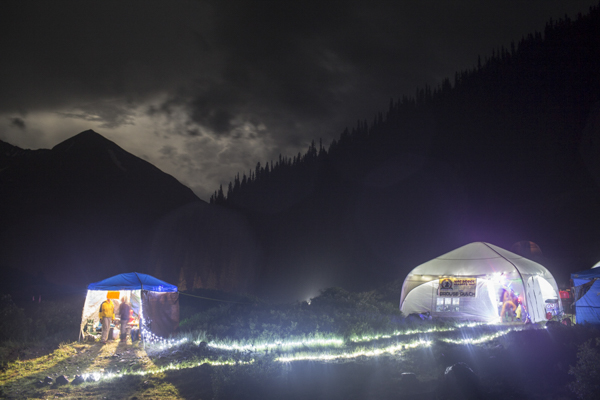
Grouse Gulch Aid Station, Mile 58, photo from http://running.competitor.com/2014/07/photos/photos-colorados-grueling-hardrock-100_107995
Space and chairs were scarce. Crew members were told to stay out until their runners arrived. Some runners cocooned and passed out in sleeping bags; others stripped out of wet clothes and shivered violently until a volunteer loaned them blankets.
I hung to the side until I saw Garett and his pacer, Eric, approaching. Cold and hungry, they looked as if all the blood had drained from their faces, as if they had survived a week adrift on an Arctic floe.
I can’t recall exactly what Garett mumbled, but it might have been “insane” … “worst ever.” And then he said, “The fog, the fog,” like Kurtz intoning, “The horror, the horror.”
As if rain and lightning weren’t enough, a cloud had descended on runners over Engineer Pass and reduced their visibility to nearly nothing. The fog threw gray mist at their headlamp beams, mocking their attempts to see more than a step ahead and spot trail markers.
Numbness rendered Garett’s and Eric’s hands nearly useless, so I helped them refill their water bottles, dry out their gloves and warm up. A short time later and a little more fortified, they headed out toward Handies Peak, the tallest mountain on the course.
Sometime around 2:30 a.m., Betsy made it to the tent with Jack, whose pacing shift was ending.
“My body’s not feeling right,” Betsy mumbled, shivering. Jack whispered to me that Betsy had been very quiet on the trail and didn’t feel like talking. We sat her down near a portable heater, got her soup and helped her change into a pair of dry tights.
Out of the corner of my eye, I noticed a single trekking pole standing behind a chair. I had propped up my two poles nearby. With so many people and so much gear in a small space, I protectively kept an eye on our stuff. I thought it was odd that a single pole stood near an empty chair. Whatever.
It was 2:45 a.m. and Betsy wanted to get going before she got colder and stiffer. I said, “Let’s do it!”
I turned to grab my poles—and they were gone.
“Where’d they go?” I wailed. We looked around and found one, but not both, lying on the ground. Nearby, that other single pole still stood there.
Someone explained that a guy named Randy had come in saying one of his poles snapped in the snow over Oscar’s, so he’d been trekking with just one. He left the aid station a little while ago—and he must have taken one of mine by accident, leaving his single pole behind.
On the verge of panic, I was like a chin-quivering, pacifier-addicted toddler who’s about to pitch a fit when he can’t find his binky. But then, like the voice of God, the words of Andy Jones-Wilkins entered my head.
I had recently listened to this podcast interview with AJW, about coping with unexpected problems on the run, and he told a story about how his meticulous gear plan was ruined in an instant at the 2006 Western States 100. He had counted on having three bottles (two hand-helds, one waist-pack) to get him through the hot canyons, but an aid station worker at Mile 43 accidentally broke the nozzle off one of the bottles. AJW was on the verge of freaking out—”for about a minute, I started to become that total aid station jerk”—but something in him said, “It’s not gonna be so bad. Move on.”
“It’s what you do in that moment of facing that problem that really ends up defining you,” he said.
All that flashed through my head as I made a snap decision to take Randy’s forgotten pole and pair it with my single one, even though the other pole was 5 inches taller and noticeably heavier.
“Ready?” Betsy asked, semi-delirious and oblivious to my pole problem.
“Yep!” Then I did my best Tim Gunn impersonation and repeated his Project Runway tagline, “Make it work!”

I followed Betsy out of the aid station, down the lighted pathway, up the trail, into near-darkness. Clouds shrouded the full moon, but enough light came through to silhouette the massive mountainside, which loomed as a false summit. The actual Handies summit was out of sight more than 3000 feet higher and five miles up the switchbacks, scree and snow.
I was ready to do everything I could to help Betsy hike and run over several more summits, to traverse boggy canyons and sweeping alpine basins, to ford knee-high rivers and fight back nausea—to do whatever it took to get to Mile 91, where Helen would meet us and pace the last nine miles with Betsy.
I was ready to ascend my first 14’er on a dark and stormy night.

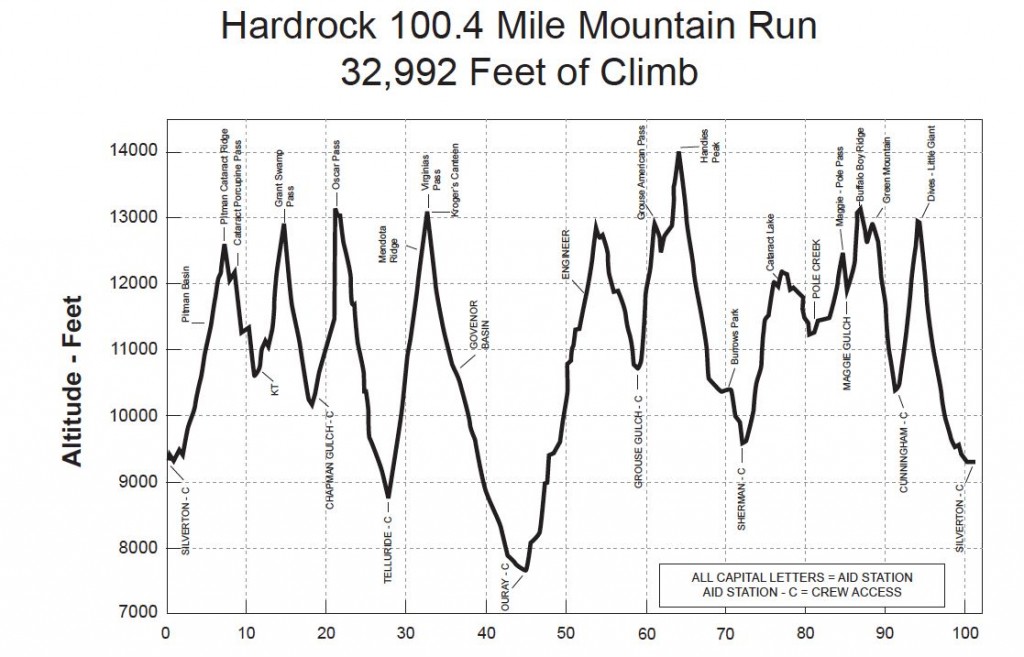
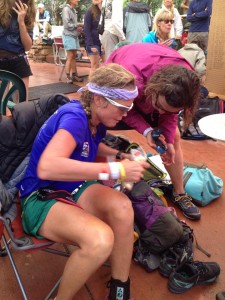
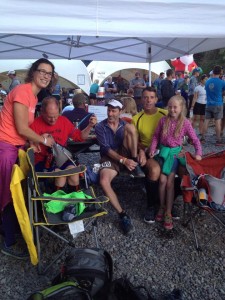
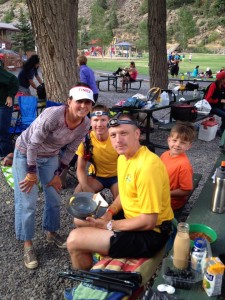
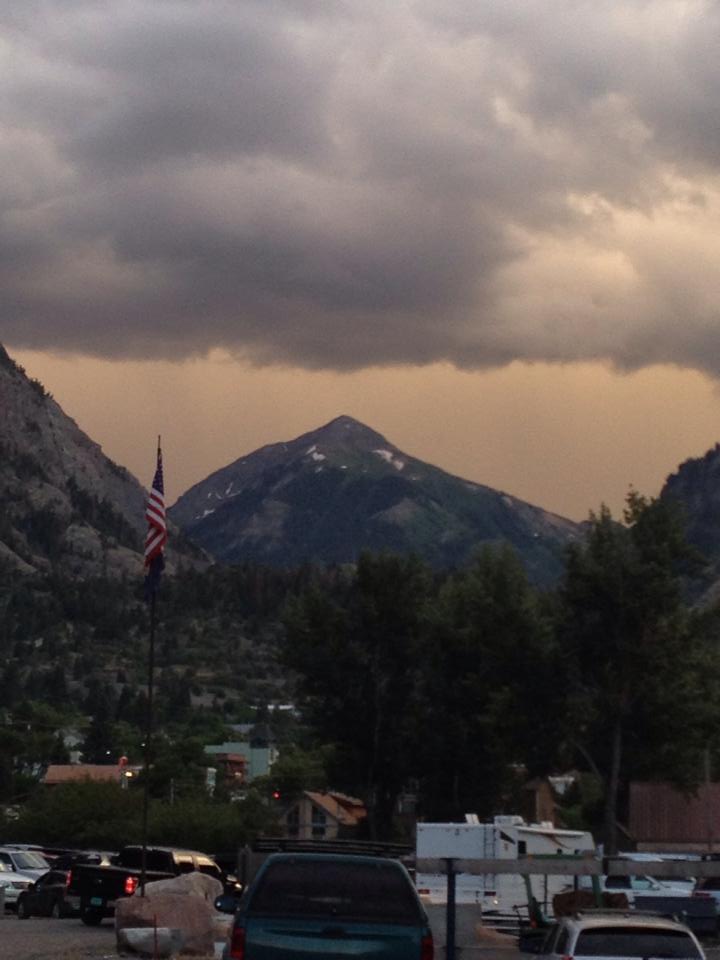
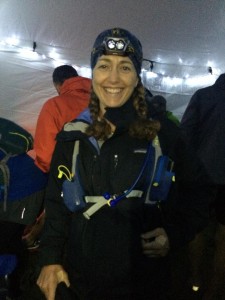
You got Putin right! Sarah, that was awesome. Not only you’re a fantastic writer, you loved through things there that mean a world to me, so thank you for finding words to share. And that AJW quote? Priceless. p.s. I better learn to operate my new poles for next year!
OMG…when are you publishing part 2?? I’m on the edge of my seat. You write so well, Sar. This is a scary story.
Part 1, you haven’t even started running with her yet, and already with the Heart of Darkness references! Sure to be an epic. Yes, that’s Hardrock. I could picture every single moment you describe here, Sarah. Can’t wait to hear the rest of it!
I also can’t wait until Part 2, as I was witness to most of Part 1 (still a great read, I must say!) I was also particularly struck by the carnage coming into Grouse. As I witnessed the whole incident with your poles unfold, I could see your troubled, broken heart, and how amazingly well you dealt with it. Pacers don’t get to have crises. You know that and you rocked that! xox
Very well written, I look forward to reading the next installment
Sarah, I love it!You are profound!Outstanding writter!Looking forward to the rest.You are a inspiration.Aloha Betsy
Fantastic, Sarah. I can just imagine how you felt about your missing pole! But you handled it with, I think the right word here is “aplomb.” I love your account of this adventure! (Oh, and Betsy, you are the COOLEST to let her right about the shart!)
right = write. Jeez, Jennifer.
Great report, Sarah!
HaHa,sorry about me snitching your pole Sarah!It looked more user friendly than my beat-up old one.Guess what,the one Jack brought to me after the race wasn’t mine either!So you snitched someone elses pole!Didn’t notice till later on way home,maybe i need to get glasses as i get older.Excellent report.
So fun to have you out here over the weekend and to get caught up in all the Hardrock drama. Great report, though was Handies really your first 14er (or just the first one in the dark)? If so, we need to get you out here to scale some more.
See you in Honduras!
–David